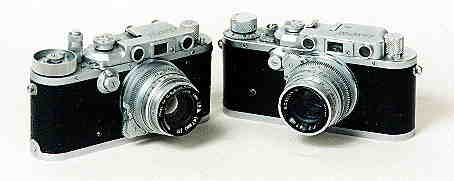
Photographica Pages
An online guide to collectable cameras and related stuff
Premier Instrument (Kardon)

Military and civilian models of the Kardon
The declaration of war on Germany by the United States left the military without a source of precision cameras. Most quality cameras at that time were German. Property owned by companies located in enemy countries was seized. The American division of Leica, E. Leitz N.Y., was placed under control of the Alien Property Custodian. It was asked to provide Leica cameras for military use. It was assumed that since they had the parts, tools and skill to repair cameras, that they would be able to manufacture them.
Whether they couldn't, or maybe wouldn't (this was a German company, and I'm sure many of the key people were sympathetic to the German cause). It wasn't to be.
Kodak was the obvious American company to step up to the task. In his book "The Kardon Story", Jerome Katz suggests that Kodak did not want to dirty their hands with a patent imfringment, even a legal one. If you follow the history of Kodak, you will find it full of patent infringments and crushed smaller companies. Indeed, it was not that long ago that Kodak was taken to court and successfully sued by Polaroid. So I doubt that this was the reason they declined the job. I would guess that Kodak saw the financial loss looming ahead for whoever took on the task. Incidentally, they were correct on that count.
It was Peter Kardon who took up the challenge. In a move that could be considered patriotic, or perhaps optimistic, the price was quoted per piece on an order for 6000 units. The order was later reduced to 2000, then to 750, without raising the per unit price. The original contract called for using tools and dies from Leitz NY, which were later determined to be of no use.
Unfortunately for Kardon, the camera was not completed before the war was. The military canceled the contract, and Kardon only received about 10% of what he invested in development of the camera. He released the camera for sale to the general public in a civilian version in 1947. However, it had difficulty competing with the cheaper Japanese Leica copies, and it is estimated that fewer than 2000 of them were built. The camera was discontinued in 1948.
In 1947, Peter Kardon took on another government project. He modified the Kardon for use in areas of extreme temperatures. The camera was designed to withstand temperatures as low as - 70 degrees and as high as 150 degrees. The controls are designed for operation with gloves. The government ordered 1650, and an additional 200 piece overrun was sold to the public.
Shortly after the Kardon was certified as by the military as a cold weather camera, Peter Kardon died. This marked the end of photographic manufacture for Premier Instruments.
All of the Kardons, both military and civilian were provided with 47/2 Kodak Ektar lenses. These lenses were mounted in the focusing mount by Premier.
